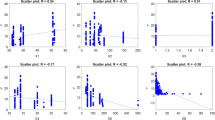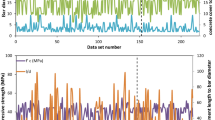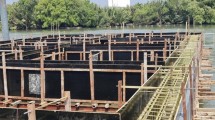Abstract
The reinforced concrete (RC) infrastructure can be retrofitted by adhesively bonding fiber-reinforced polymers (FRPs) to the tension face. In the FRP-to-concrete bonding system, the debonding of the FRP plate from the member is the most common failure type. Predicting the bond strength of FRP-to-concrete joints using traditional predictive models is far from being satisfactory because of the highly nonlinear relationships between the bond strength and a large number of influencing variables. To address this issue, this study proposes a metaheuristic-optimized least-squares support vector regression (LSSVR) model to predict the bond strength of FRP-to-concrete joints. The hyperparameters of the LSSVR model are tuned using a recently proposed beetle antennae search (BAS) algorithm. In addition, the Levy flight is incorporated in the BAS algorithm to improve its searching efficiency. The proposed model is then trained on a dataset collected from internationally published literature. To understand the importance of each input variable on the bond strength, the variable importance is calculated using the random forest algorithm. The results show that the proposed LBAS-LSSVR model has comparatively high prediction accuracy, as indicated by a high correlation coefficient (0.983) and low root mean square error (1.99 MPa) on the test set. Width of FRP is the most sensitive variable to the bond strength. The proposed model can be extended to solve other regression problems in structural engineering.










Similar content being viewed by others
Explore related subjects
Discover the latest articles, news and stories from top researchers in related subjects.References
Altman NS (1992) An introduction to kernel and nearest-neighbor nonparametric regression. Am Stat 46(3):175–185
Basak D, Pal S, Patranabis DC (2007) Support vector regression. Neural Inf Process Lett Rev 11(10):203–224
Bizindavyi L, Neale K (1999) Transfer lengths and bond strengths for composites bonded to concrete. J Compos Constr 3(4):153–160
Boddy R, Smith G (2009) Statistical methods in practice: for scientists and technologists. Wiley, New York
Bonacci J (1996) Strength, failure mode and deformability of concrete beams strengthened externally with advanced composites. Paper presented at the proceedings of the 2nd international conference on advanced composite materials in bridges and structures, ACMBS-II, Montreal 1996
Boyd S, Vandenberghe L (2004) Convex optimization. Cambridge University Press, Cambridge
Braga-Neto U, Dougherty E (2004) Bolstered error estimation. Pattern Recognit 37(6):1267–1281
Braga-Neto U, Hashimoto R, Dougherty ER, Nguyen DV, Carroll RJ (2004) Is cross-validation better than resubstitution for ranking genes? Bioinformatics 20(2):253–258
Burges CJ (1998) A tutorial on support vector machines for pattern recognition. Data Min Knowl Disc 2(2):121–167
Ceroni F, Ferracuti B, Pecce M, Savoia M (2014) Assessment of a bond strength model for FRP reinforcement externally bonded over masonry blocks. Compos B Eng 61:147–161
Chajes MJ, Finch WW, Thomson TA (1996) Bond and force transfer of composite-material plates bonded to concrete. Struct J 93(2):209–217
Chajes MJ, Januszka TF, Mertz DR, Thomson TA, Finch WW (1995) Shear strengthening of reinforced concrete beams using externally applied composite fabrics. Struct J 92(3):295–303
Cristianini N, Shawe-Taylor J (2000) An introduction to support vector machines and other kernel-based learning methods. Cambridge University Press, Cambridge
Dai J, Ueda T, Sato Y (2005) Development of the nonlinear bond stress–slip model of fiber reinforced plastics sheet–concrete interfaces with a simple method. J Compos Constr 9(1):52–62
Efron B, Tibshirani RJ (1994) An introduction to the bootstrap. CRC Press, Boca Raton
Farrar DE, Glauber RR (1967) Multicollinearity in regression analysis: the problem revisited. Rev Econ Stat 1967:92–107
Fu B, Chen G, Teng J (2017) Mitigation of intermediate crack debonding in FRP-plated RC beams using FRP U-jackets. Compos Struct 176:883–897
Genuer R, Poggi J-M, Tuleau-Malot C (2010) Variable selection using random forests. Pattern Recognit Lett 31(14):2225–2236
Gupta S (2007) Support vector machines based modelling of concrete strength. World Acad Sci Eng Technol 36:305–311
Hadi M (2003) Retrofitting of shear failed reinforced concrete beams. Compos Struct 62(1):1–6
Hecht-Nielsen R (1992) Theory of the backpropagation neural network. In: Neural networks for perception. Elsevier, pp 65–93
Hosmer DW Jr, Lemeshow S, Sturdivant RX (2013) Applied logistic regression, vol 398. Wiley, New York
Hsu C-W, Chang C-C, Lin C-J (2003) A practical guide to support vector classification
Hyndman RJ, Koehler AB (2006) Another look at measures of forecast accuracy. Int J Forecast 22(4):679–688
Jiang X, Li S (2017) BAS: beetle antennae search algorithm for optimization problems. arXiv preprint arXiv:1710.10724
Kalfat R, Gadd J, Al-Mahaidi R, Smith ST (2018) An efficiency framework for anchorage devices used to enhance the performance of FRP strengthened RC members. Constr Build Mater 191:354–375
Keerthi SS, Lin C-J (2003) Asymptotic behaviors of support vector machines with Gaussian kernel. Neural Comput 15(7):1667–1689
Khalifa A, Nanni A (2002) Rehabilitation of rectangular simply supported RC beams with shear deficiencies using CFRP composites. Constr Build Mater 16(3):135–146
Kim J-H (2009) Estimating classification error rate: repeated cross-validation, repeated hold-out and bootstrap. Comput Stat Data Anal 53(11):3735–3745
Kohavi R (1995) A study of cross-validation and bootstrap for accuracy estimation and model selection. Paper presented at the Ijcai
Kotsiantis SB, Zaharakis I, Pintelas P (2007) Supervised machine learning: a review of classification techniques. Emerg Artif Intell Appl Comput Eng 160:3–24
Lewis RJ (2000). An introduction to classification and regression tree (CART) analysis. Paper presented at the Annual meeting of the society for academic emergency medicine in San Francisco, California
Lin H-T, Lin C-J (2003) A study on sigmoid kernels for SVM and the training of non-PSD kernels by SMO-type methods. Neural Comput 3:1–32
Lu X, Teng J, Ye L, Jiang J (2005) Bond–slip models for FRP sheets/plates bonded to concrete. Eng Struct 27(6):920–937
Mander JB, Priestley MJ, Park R (1988) Theoretical stress-strain model for confined concrete. J Struct Eng 114(8):1804–1826
Mashrei MA, Seracino R, Rahman M (2013) Application of artificial neural networks to predict the bond strength of FRP-to-concrete joints. Constr Build Mater 40:812–821
Mirjalili S, Mirjalili SM, Yang X-S (2014) Binary bat algorithm. Neural Comput Appl 25(3–4):663–681
Neter J, Kutner MH, Nachtsheim CJ, Wasserman W (1996) Applied linear statistical models, vol 4. Irwin, Chicago
Owolabi TO, Oloore LE, Akande KO, Olatunji SO (2019) Modeling of magnetic cooling power of manganite-based materials using computational intelligence approach. Neural Comput Appl 31(2):1291–1298
Pavlyukevich I (2007) Lévy flights, non-local search and simulated annealing. J Comput Phys 226(2):1830–1844
Ren H (2003) Study on basic theories and long time behavior of concrete structures strengthened by fiber reinforced polymers. Dalian University of Technology
Ripley BD (2007) Pattern recognition and neural networks. Cambridge University Press, Cambridge
Sharma S, Ali MM, Goldar D, Sikdar P (2006) Plate–concrete interfacial bond strength of FRP and metallic plated concrete specimens. Compos B Eng 37(1):54–63
Shlesinger MF (2006) Mathematical physics: search research. Nature 443(7109):281
Smith ST, Teng JG (2002) FRP-strengthened RC beams. I: review of debonding strength models. Eng Struct 24(4):385–395. https://doi.org/10.1016/S0141-0296(01)00105-5
Smola AJ, Schölkopf B (2004) A tutorial on support vector regression. Stat Comput 14(3):199–222. https://doi.org/10.1023/B:STCO.0000035301.49549.88
Sonebi M, Cevik A, Grünewald S, Walraven J (2016) Modelling the fresh properties of self-compacting concrete using support vector machine approach. Constr Build Mater 106:55–64. https://doi.org/10.1016/j.conbuildmat.2015.12.035
Soudki K, Alkhrdaji T (2005) Guide for the design and construction of externally bonded FRP systems for strengthening concrete structures (ACI 440.2 R-02). Paper presented at the Structures Congress 2005: Metropolis and Beyond
Stone M (1974) Cross-validatory choice and assessment of statistical predictions. J Roy Stat Soc: Ser B (Methodol) 1974:111–147
Sun Y, Zhang J, Li G, Ma G, Huang Y, Sun J, Nener B (2019) Determination of Young’s modulus of jet grouted coalcretes using an intelligent model. Eng Geol 252:43–53
Sun Y, Zhang J, Li G, Wang Y, Sun J, Jiang C (2019) Optimized neural network using beetle antennae search for predicting the unconfined compressive strength of jet grouting coalcretes. Int J Numer Anal Methods Geomech 43(4):801–813
Suykens JA, Vandewalle J (1999) Least squares support vector machine classifiers. Neural Process Lett 9(3):293–300
Takeo K, Matsushita H, Makizumi T, Nagashima G (1997) Bond characteristics of CFRP sheets in the CFRP bonding technique. Proc Jpn Concr Inst 19(2):1599–1604
Toutanji H, Saxena P, Zhao L, Ooi T (2007) Prediction of interfacial bond failure of FRP–concrete surface. J Compos Constr 11(4):427–436
Tureyen AK, Frosch RJ (2002) Shear tests of FRP-reinforced concrete beams without stirrups. Struct J 99(4):427–434
Van Gemert D (1980) Force transfer in epoxy bonded steel/concrete joints. Int J Adhes Adhes 1(2):67–72
Viswanathan GM, Afanasyev V, Buldyrev S, Murphy E, Prince P, Stanley HE (1996) Lévy flight search patterns of wandering albatrosses. Nature 381(6581):413
Woo S-K, Lee Y (2010) Experimental study on interfacial behavior of CFRP-bonded concrete. KSCE J Civ Eng 14(3):385–393
Yan K, Shi C (2010) Prediction of elastic modulus of normal and high strength concrete by support vector machine. Constr Build Mater 24(8):1479–1485. https://doi.org/10.1016/j.conbuildmat.2010.01.006
Yan K, Xu H, Shen G, Liu P (2013) Prediction of splitting tensile strength from cylinder compressive strength of concrete by support vector machine. Advances in Materials Science and Engineering, 2013
Yao J, Teng J, Chen J (2005) Experimental study on FRP-to-concrete bonded joints. Compos B Eng 36(2):99–113
Zhang J, Huang Y, Ma G, Nener B (2020) Multi-objective beetle antennae search algorithm. arXiv preprint arXiv:2002.10090
Zhang J, Huang Y, Ma G, Sun J, Nener B (2020) A metaheuristic-optimized multi-output model for predicting multiple properties of pervious concrete. Constr Build Mater 249:118803
Zhang J, Li D, Wang Y (2020) Predicting uniaxial compressive strength of oil palm shell concrete using a hybrid artificial intelligence model. J Build Eng 30:101282
Zhang J, Li D, Wang Y (2020) Toward intelligent construction: prediction of mechanical properties of manufactured-sand concrete using tree-based models. J Clean Prod 258:120665
Zhang J, Ma G, Huang Y, Aslani F, Nener B (2019) Modelling uniaxial compressive strength of lightweight self-compacting concrete using random forest regression. Constr Build Mater 210:713–719
Zhao H, Zhang Y, Zhao M (2000) Research on the bond performance between CFRP plate and concrete. Paper presented at the Proc., 1st Conf. on FRP Concrete Structures of China
Ziraba Y, Baluch M, Basunbul I, Azad A, Al-Sulaimani G, Sharif A (1995) Combined experimental-numerical approach to characterization of steel-glue-concrete interface. Mater Struct 28(9):518–525
Acknowledgements
The first author is supported by China Scholarship Council (Grant Number: 201706460008).
Author information
Authors and Affiliations
Corresponding author
Ethics declarations
Conflict of interest
The authors declare that they have no conflict of interest.
Additional information
Publisher's Note
Springer Nature remains neutral with regard to jurisdictional claims in published maps and institutional affiliations.
Rights and permissions
About this article
Cite this article
Zhang, J., Wang, Y. Evaluating the bond strength of FRP-to-concrete composite joints using metaheuristic-optimized least-squares support vector regression. Neural Comput & Applic 33, 3621–3635 (2021). https://doi.org/10.1007/s00521-020-05191-0
Received:
Accepted:
Published:
Issue Date:
DOI: https://doi.org/10.1007/s00521-020-05191-0




